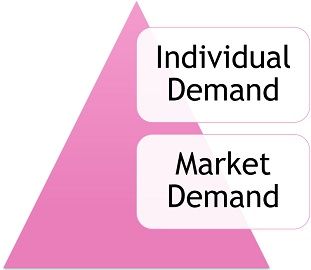 Based on the number of consumers, demand is classified as individual demand and market demand. Individual demand implies, the quantity of good or service demanded by an individual household, at a given price and at a given period of time. For example, the quantity of detergent purchased by an individual household, in a month, is termed as individual demand.
Based on the number of consumers, demand is classified as individual demand and market demand. Individual demand implies, the quantity of good or service demanded by an individual household, at a given price and at a given period of time. For example, the quantity of detergent purchased by an individual household, in a month, is termed as individual demand.
Unlike Market Demand implies the sum total of all individual demand for the commodity at each possible price, over a period of time. For example, There are 10 consumers of detergent in the market, wherein their monthly demand for detergent is 10kg, 5kg, 4kg, 6kg, 5kg, 3kg, 7kg, 12kg, 6kg and 4 kg respectively. So, the market demand for detergent is 62kg.
What is Demand?
In economics, demand is the desire for the commodity supported by the willingness of the consumer to spend money to buy that commodity and the ability (in terms of money) of the consumer to get the commodity.
Demand Curve
On a graph, one can draw the demand curve for any commodity by plotting the various combinations of price and demand, wherein price will be an independent variable and is taken on Y-axis, whereas quantity demanded will be a dependent variable which is plotted on X-axis.
In this written account, we will talk about the differences between individual demand and market demand.
Content: Individual Demand Vs Market Demand
- Comparison Chart
- Definition
- Key Differences
- Factors Affecting Individual Demand and Market Demand
- Example
- Conclusion
Comparison Chart
| Basis for Comparison | Individual Demand | Market Demand |
|---|---|---|
| Meaning | Individual Demand implies the quantity demanded of a commodity by a single potential consumer, firm, or household, at different price levels, and during a given period. | Market demand for a commodity refers to the aggregate quantity of the commodity demanded by all the potential consumers in the market at different price levels, over a certain period. |
| Curve | Depicts the relationship between quantity demanded by a single consumer, as we change the price. | Depicts the relationship between the total quantity demanded and the market price of the goods. |
| Inter-Relationship | Component of Market Demand. | Summation of Individual demand of all buyers. |
| Demand curve appears | Steeper | Relatively flatter |
| Law of Demand | It does not always follow the law of demand | It always follows the law of demand. |
Definition of Individual Demand
Individual Demand implies the quantity of a good or service which an individual is willing to buy at a certain price over a period of time, i.e. per week, per month or per year. In simple words, Individual demand is the demand for a commodity by an individual buyer.
The individual demand for the product is commonly affected by the price of the commodity, income of the consumer, and taste and preferences, etc.
Individual Demand Schedule
An individual demand schedule is a tabular representation of the list of quantities of a commodity demanded by an individual at different price levels, during a certain period of time.
For Example, Given are the price per kg of oranges and the quantity demanded by a consumer.
Individual Demand Curve
An individual demand curve represents the quantity demanded by the individual household at various prices. We can also say that it is the graphical representation of the individual demand schedule. It can be constructed by observing consumer behaviour when there is a change in price.
For Example: Considering the above example, the curve will be drawn as follows:
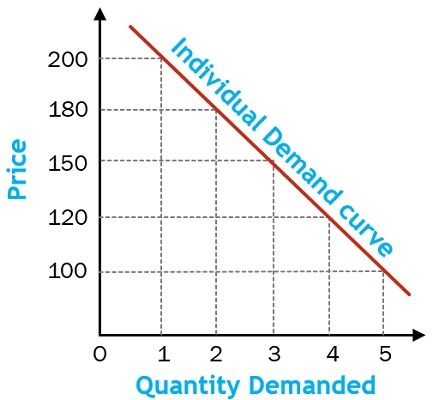
Also Read: Difference Between Demand and Supply
Definition of Market Demand
Market Demand refers to the sum total of the individual demands of all the consumers for a commodity in a market over a period of time, at given prices, other factors being constant.
Market Demand Schedule
A market demand schedule is a tabular representation indicating how much quantity of a commodity the consumers are willing and able to buy in a market at different prices, during a specified period of time. Basically, it is a sum of the individual demand schedules, indicating the preference scale of different consumers taken together, at different price levels.
For Example: Given are the price per kg of sugar and the quantity demanded by all four consumers in the market – A, B, C and D.

Market Demand Curve
The market demand curve graphically indicates the horizontal sum of the individual demand curves. With the help of market demand, the firm can understand the entire market and not just individual customers.
For Example: Considering the above example, the curve will be plotted as under: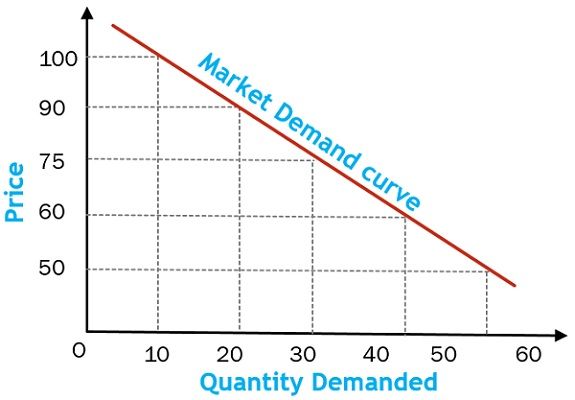
Also Read: Difference Between Demand and Quantity Demand
Key Differences Between Individual Demand and Market Demand
After understanding their concept, come let’s have a look at the difference between individual demand and market demand:
- Individual demand connotes the quantity demanded by a single consumer, for any given product, at any given price, at any point in time. On the other hand, market demand is the aggregate quantity that all the consumers of a commodity are willing and able to buy at a point of time, in a market at different possible prices.
- Both Individual Demand Curve and Market Demand Curve have a negative slope, i.e. from left to right showing an indirect functional relationship between the price of the commodity and the quantity demanded. Other things being constant, an individual demand curve showcases the relationship between quantity demanded by a single consumer, as we change the price. Conversely, the market demand curve indicates the relationship between the total quantity demanded and the market price of the goods.
- While individual demand is a component of market demand. On the other hand, market demand is the summation of all individual demand of all consumers.
- The market demand curve is flatter in comparison to the individual demand curve.
- Individual demand does not always follow the law of demand whereas market demand always follows the law of demand. As per the law of demand, when there is an increase in the price of the commodity, the quantity demanded will decrease.
Factors Affecting Individual Demand and Market Demand
Behind a buying decision of an individual, there are a number of factors involved. However, there are some common factors which affect both individual demand and market demand. And there are some factors which affect market demand only. So, first of all we are going to discuss those factors which affect both: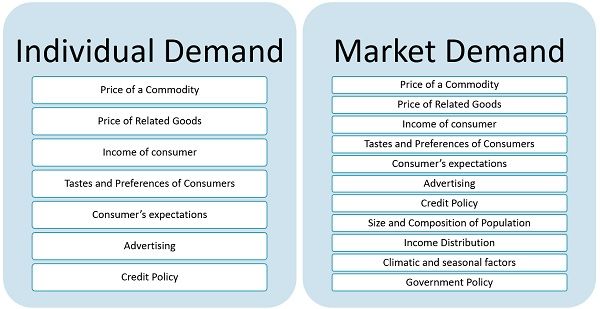
- Price of a Commodity: The price of a commodity plays a crucial role in determining the demand for a commodity. It has an inverse relationship with demand, which means that when the price of good increases, demand falls, and when the prices are reduced, the quantity demanded of that product increases.
- Price of Related Goods: The term ‘related goods’ is used in the context of substitute goods and complementary goods. The demand for the good is not just based on its own prices, but on the other goods which are related to it. Here, goods are considered as related when the change in the price of one commodity, influences the demand for another commodity.
- Substitute Goods: Goods that are used to fulfil or satisfy the same purpose or want are called substitute goods or competing goods, For example bulb and tube light, Cooler and AC, etc.
- Complementary Goods: Complementary Goods are the goods that have joint demand, i.e. such goods are consumed together. Hence, the rise in the prices of one commodity leads to a fall in the prices of another. For example shoes and socks.
- Income of consumer: We all know that the level of income of a consumer determines its purchasing power. That is why there is a direct relationship between the demand for the product and the income of the consumer. So, when the income of the consumer rises, the demand for the product will also rise and vice versa.
- Tastes and Preferences of Consumers: Demand for commodity changes with the change in tastes and preferences of the consumer, depending on the fashion, traditions, beliefs, habits, trends, customs and lifestyles.
- Consumer’s expectations: Consumer’s expectations with respect to the future price and availability of goods and services, and changes in income, which may result in a sudden rise or fall in demand.
- Advertising: Nowadays, advertising and media, be it electronic, paper-based or social, play a key role in influencing the lifestyle of the consumers. An aggressive advertising campaign often increases the demand for a particular commodity. Thus it shifts the demand curve to the right.
- Credit Policy: Credit policy of the company relating to the terms and conditions, to provide various commodities on credit. As well as the bank’s credit policy also affects the demand for commodities. This implies that if the credit policies and interest rates are favourable, the consumers may purchase those commodities which they may not have purchased otherwise.
The factors which only affect market demand for the commodity are:
- Size and Composition of Population: When there is an overall increase in the size of the population, it leads to an increase in the demand for the commodity, due to the increase in the number of consumers. Further, the composition of the population affects the demand for commodities, as the demand for the commodity is primarily based on the age, sex and race of the population. Therefore, the composition of the population will decide the pattern of market demand.
- Income Distribution: Income distribution indicates the way national income is divided among various groups, classes, factors of production, etc. When the distribution of income is unequal, it may lead to a difference in the income status of different individuals in a country. So, people belonging to the rich class would have higher purchasing power, as compared to the poor class, which results in higher demand for the commodity among rich but less amongst poor. More even income distribution implies more market demand.
- Climatic and seasonal factors: Climatic or seasonal conditions of a region also affects demand for the commodities, such as the demand for coolers, air conditioner, ice cream and cold drinks are high in summer as compared to winters.
- Government Policy: Taxation level, budget, the supply of money and interest rate, also affect the demand for the commodities For example, when the government increases VAT on petrol, it ultimately increases its price, which results in the fall in their demand.
Example
Individual Demand
When the price of apples is Rs. 60 per kg, Amar purchases 3 kg apples for a week. And when the price rises to Rs. 80 per kg, he buys 2 kg apples for the week, but when the price reduced to 40 Rs per kg, he buys 4 kg apples. This will be shown in the table below:
Now, take a look at the individual demand curve, considering quantity demanded of apples by Amar at different price levels.
Market Demand
Suppose there are three buyers of apples in a market – Amar, Ali and Alex. The market demand will be the aggregate of individual demand schedules of the given buyers. This will be shown in the table below: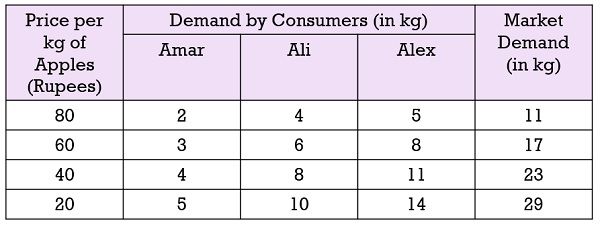
Let us take a look at the market demand curve, considerating the total quantity demanded by all the consumers at different prices.
Conclusion
In a nutshell, we can say that individual demand for the commodity is not the same as market demand. Further, individual demand is not influenced by all the factors affecting market demand.
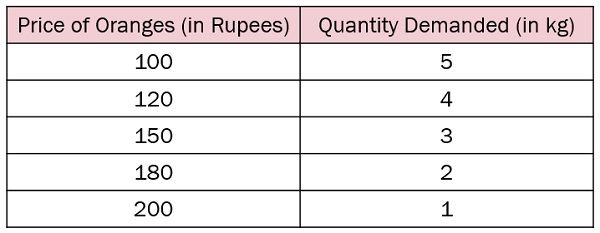

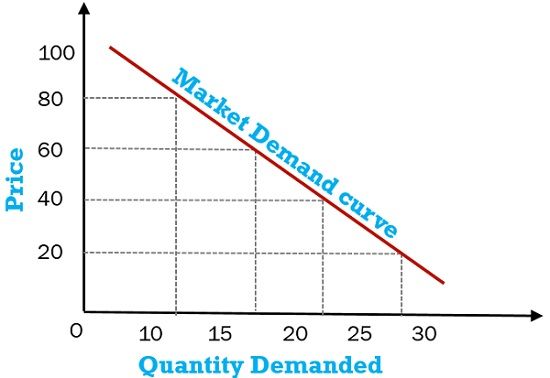






Sharma says
Very good
Explanation
Ogunniran Esther Ayomide says
Wow